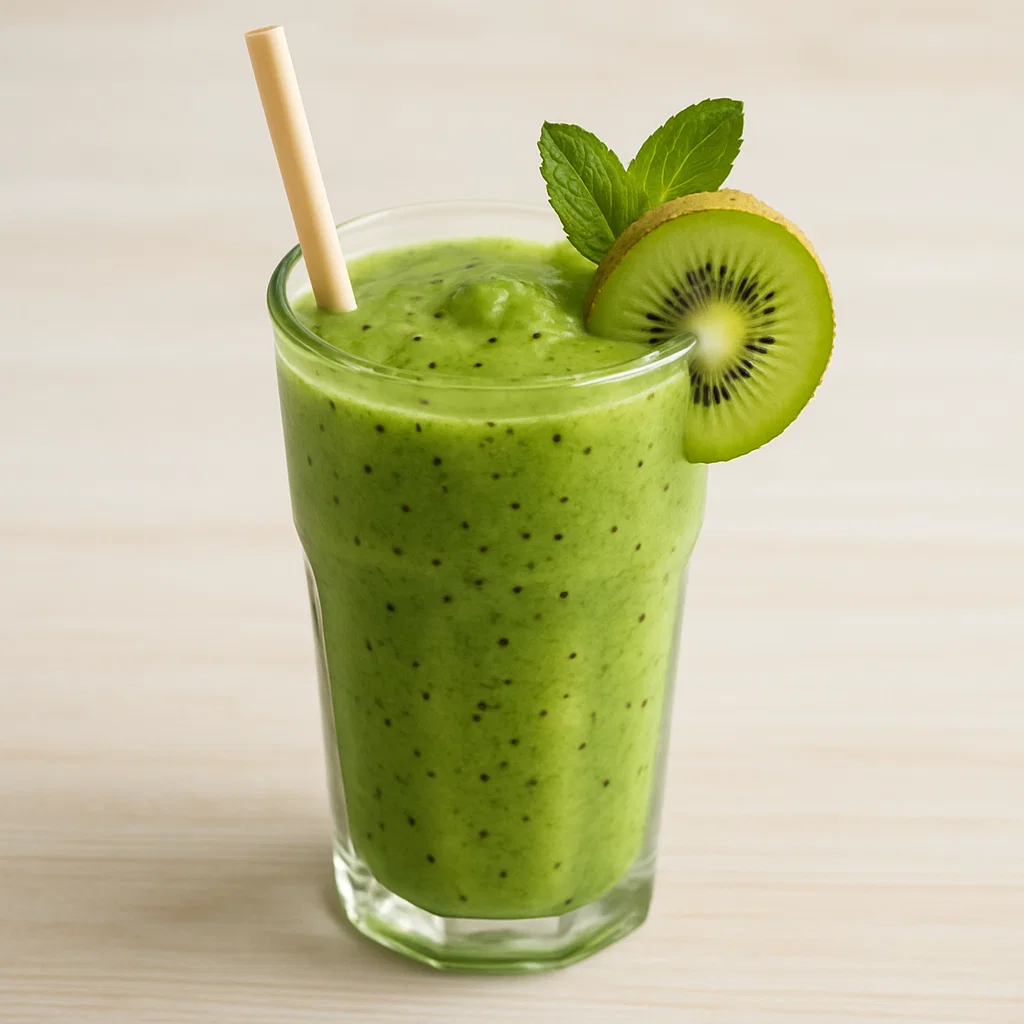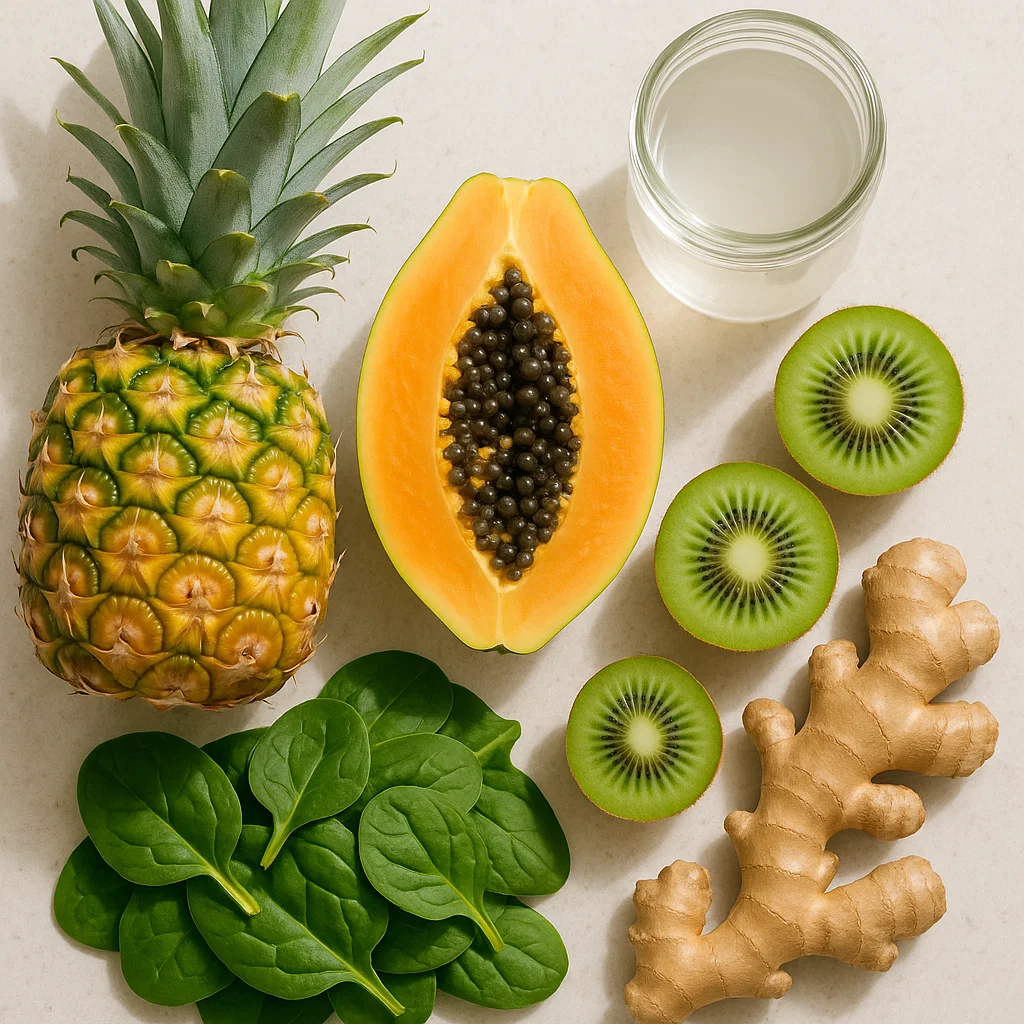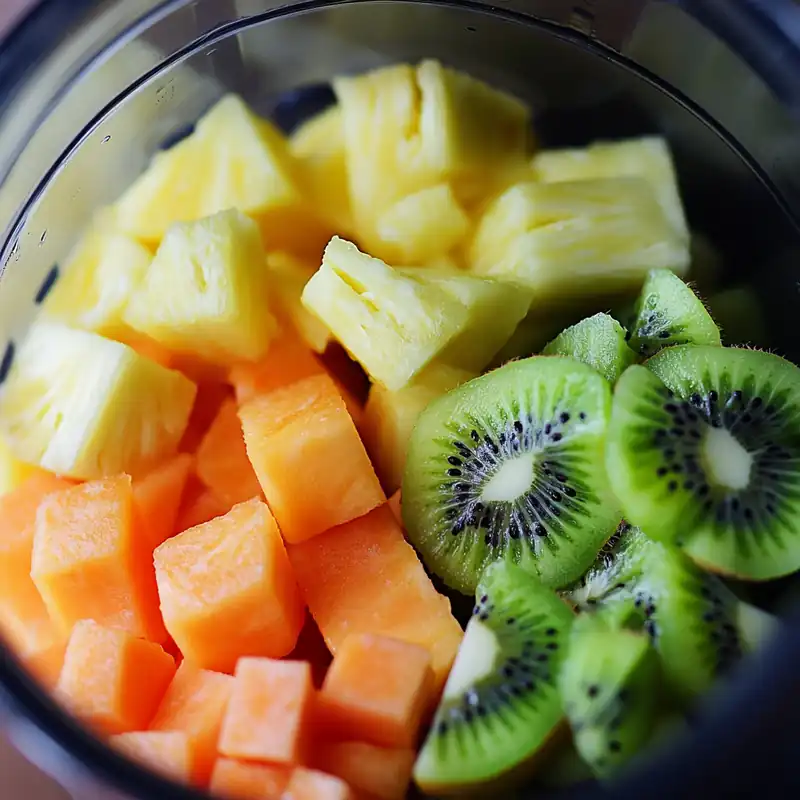When I first started making smoothies, I was simply looking for a quick breakfast before work. Over time, I noticed something else: blending fruits, leafy greens, and enzyme-rich ingredients actually eased bloating and kept me feeling steady throughout the day. That’s when I began experimenting with what I now call my digestive enzyme smoothie. It reminded me of family meals back home, where fresh pineapple and papaya were always on the table. Those fruits naturally contain enzymes like bromelain and papain, which help break down food and make digestion easier. Including them in a smoothie felt like carrying a piece of home into my busy mornings.
Why smoothies became a daily ritual

After long days filled with problem-solving at my job, I needed meals that were easy on my system. Smoothies checked all the boxes: quick, nourishing, and customizable. More importantly, when paired with enzyme-rich ingredients, they became a natural support for my digestive health. Instead of relying on supplements alone, I found that whole-food sources of enzymes worked beautifully in blended form. A smoothie could be refreshing, filling, and functional all at once. This is why the digestive enzyme smoothie became more than just a recipe it turned into a ritual that keeps me balanced and grounded.
Table Of Content
Table of Contents
Digestive Enzyme Smoothie
- Total Time: 5 minutes
- Yield: 2 servings 1x
- Diet: Vegetarian
Description
A refreshing digestive enzyme smoothie made with pineapple, papaya, kiwi, spinach, and ginger to support gut health and boost energy.
Ingredients
1 cup pineapple chunks
1 cup papaya chunks
1 kiwi, peeled
1 handful spinach
1 small piece fresh ginger
1 cup coconut water (or almond milk)
1 banana (optional, for creaminess)
Ice cubes as needed
Instructions
Add pineapple, papaya, kiwi, spinach, and ginger to blender.
Pour in coconut water or almond milk.
Blend until smooth and creamy.
Add banana and ice cubes for extra creaminess and chill.
Pour into a glass and serve immediately.
Notes
Best enjoyed fresh. You can swap spinach for kale or add flaxseeds for extra fiber.
For a creamier smoothie, replace coconut water with almond milk
- Prep Time: 5 minutes
- Category: Beverages
- Method: Blended
- Cuisine: Healthy
Nutrition
- Serving Size: 1 glass
- Calories: 150
- Sugar: 18g
- Sodium: 45mg
- Fat: 2g
- Saturated Fat: 0.5g
- Unsaturated Fat: 1.5g
- Trans Fat: 0
- Carbohydrates: 34g
- Fiber: 5g
- Protein: 2g
- Cholesterol: 0
Keywords: digestive enzyme smoothie, gut health smoothie, pineapple papaya smoothie
Health Benefits of Digestive Enzyme Smoothies
How digestive enzymes support your body
Every time we eat, our bodies rely on enzymes to break down food into nutrients that can be absorbed. Without them, even the most nourishing meals can leave you feeling sluggish or bloated. That’s where a digestive enzyme smoothie comes in. By blending enzyme-rich fruits like pineapple, kiwi, or papaya, you’re giving your gut a natural boost. These fruits contain compounds such as bromelain and actinidin, which help break down proteins more efficiently. The result? A smoother digestive process that allows your body to absorb vitamins and minerals more effectively.
Instead of depending on heavy meals or processed snacks, choosing a smoothie with natural enzymes supports digestion right from the start. Think of it as giving your body a head start before the day’s challenges even begin.
check my healthy smoothies here
Why adding enzymes to smoothies makes sense
The beauty of a smoothie is its versatility. You can pack in a variety of enzyme-rich foods, leafy greens, and fiber all at once. When combined, these ingredients don’t just help with digestion they also promote a balanced gut microbiome. A digestive enzyme smoothie can reduce post-meal discomfort, ease bloating, and support overall gut health.
Another big benefit is energy. When your body doesn’t waste effort struggling with digestion, you naturally feel lighter and more energized. Many people notice clearer skin, less fatigue, and even better focus when they regularly include digestive-friendly blends in their routine. For me, the difference was subtle at first but became undeniable after a few weeks it felt like I had unlocked a more sustainable source of energy.
Building the Perfect Digestive Enzyme Smoothie
Key ingredients for gut-friendly blends

Creating a digestive enzyme smoothie is all about balance. You want to mix fruits that naturally contain enzymes with fiber-rich add-ins and liquids that keep everything smooth. Start with pineapple or papaya both are powerhouse enzyme fruits. Pineapple is rich in bromelain, while papaya carries papain, and together they help break down proteins. Adding a ripe kiwi can boost the mix with actinidin, another natural digestive aid. For extra fiber and creaminess, bananas or oats are excellent choices.
Don’t forget leafy greens like spinach, which support gut health with prebiotic fibers, or ginger, which can soothe the stomach. Liquid bases such as coconut water or almond milk not only add hydration but also create a refreshing texture.
Here’s a quick reference table of popular ingredients and their digestive perks:
| Ingredient | Digestive Benefit |
|---|---|
| Pineapple | Rich in bromelain, aids protein breakdown |
| Papaya | Contains papain, supports digestion |
| Kiwi | Actinidin improves protein absorption |
| Ginger | Soothes the stomach, reduces bloating |
Flavorful combinations to try

One of my favorite blends combines pineapple, spinach, ginger, and coconut water—it’s bright, refreshing, and great for mornings. Another variation pairs papaya with banana, almond milk, and oats, which makes a creamier, more filling option. Both recipes can be tailored with extras like chia seeds, flax, or probiotics to keep your gut balanced.
Once you start experimenting, you’ll notice how easy it is to create a smoothie that’s both tasty and functional. In fact, this flexibility is why I always keep enzyme-rich fruits stocked in my kitchen.
Practical Tips for Enjoying Digestive Enzyme Smoothies
When and how to drink them
Timing can make a big difference when it comes to a digestive enzyme smoothie. Many people enjoy it first thing in the morning because the body absorbs nutrients more efficiently after fasting overnight. Others prefer drinking it about 30 minutes before a meal to give their digestive system a head start. I’ve found that sipping one mid-afternoon helps curb cravings while also keeping me energized until dinner.
Portion size also matters. A glass around 12–16 ounces is usually enough to get the benefits without feeling too full. Pairing your smoothie with a light snack, such as a handful of nuts, can make it more satisfying while still being gentle on your stomach.
Mistakes to avoid for best results
The biggest mistake people make is overloading their smoothies with too many heavy ingredients. Adding multiple dairy products or lots of processed powders can slow down digestion rather than help it. Stick to whole foods and let the natural enzymes do their job. Another common issue is relying only on supplements. While digestive enzyme capsules can be useful, blending enzyme-rich fruits with fiber and hydration creates a more balanced approach.
Lastly, consistency is key. Having a digestive enzyme smoothie once a week won’t bring dramatic results. Making it part of your daily or near-daily routine is what keeps digestion smooth and energy levels steady.
FAQs
What should not be taken with digestive enzymes?
When enjoying a digestive enzyme smoothie, it’s best to avoid pairing it with excessive alcohol or high doses of antacids. These can interfere with how enzymes work and reduce the effectiveness of the smoothie’s natural ingredients.
What to put in a smoothie for digestion?
The best base for a digestive enzyme smoothie includes pineapple, papaya, and kiwi. You can also add spinach, ginger, or flaxseeds for extra gut support. Blending these together creates a smoothie that helps ease bloating and improves nutrient absorption.
Is there any downside to taking digestive enzymes?
For most people, they’re safe. However, overuse of supplements can sometimes cause mild discomfort like gas or diarrhea. Whole-food sources in smoothies are usually gentler.
What are the signs you need digestive enzymes?
Frequent bloating, gas, or feeling overly full after meals are common signs. Low energy and nutrient deficiencies may also point to a lack of natural enzymes.
Conlusion
Making a digestive enzyme smoothie part of your day is a simple way to support gut health, boost energy, and feel lighter after meals. With natural enzyme-rich fruits like pineapple, papaya, and kiwi, plus soothing add-ins like ginger and spinach, you can create a drink that’s as functional as it is flavorful.
For me, this smoothie has become more than just a recipeit’s a ritual that connects me to family meals back home while helping me power through long days of coding. If you’re looking for a way to ease digestion, brighten your mornings, or simply enjoy a refreshing drink, this smoothie is worth adding to your weekly routine.
So grab your blender, stock up on enzyme-rich fruits, and discover how a simple smoothie can transform the way you feel every day.
